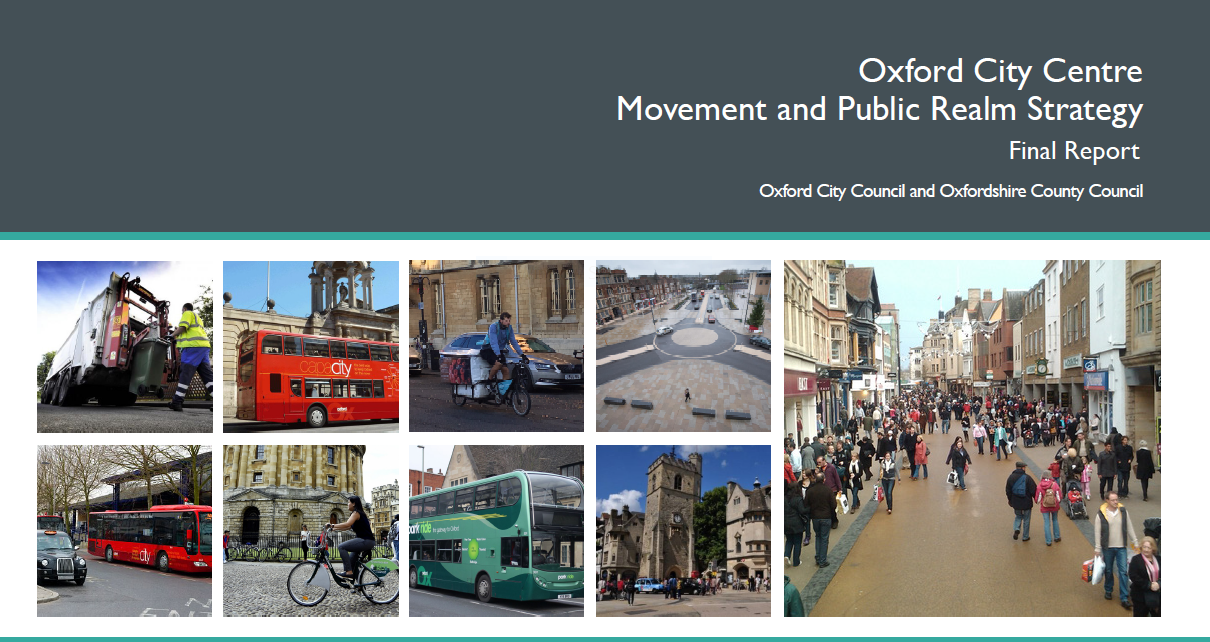Transport in Oxford city centre: Advisory study published
An independent advisory report which recommends that the High St and St Aldate’s should be made one-way for all motor vehicles to make space for segregated two-way cycle tracks and wider pavements has been published today. (Oxford City Centre Movement and Public Ream Strategy)
The report suggests that as part of the bus routing changes to enable this, streets such as Broad Street, Holywell Street and Cornmarket have the potential to be used by buses. It also identifies what it calls “pedestrian priority” streets.
The public realm in the city centre
Phil Jones Associates and ITP (Integrated Transport Planning) were commissioned last year by Oxfordshire County Council and Oxford City Council to look at all aspects of “traffic movement and the public realm” in the city centre, and to come up with proposals to challenge the status quo/cast a fresh set of eyes on the situation.
Congestion and air quality are projected to get worse in Oxford with a predicted 25% growth in car journeys to workplaces in Oxford by 2031 if nothing is done. The present traffic levels already put a huge strain on the city’s transport infrastructure and affect residents, visitors and commuters. That’s why the two councils are working together by assessing the options put forward in the report and will be engaging with stakeholders on how some of the ideas will work in practice to create a liveable and sustainable city.
The transport consultants, who carried out detailed research for the study, focused mainly on public transport, altering bus routes, improving and extending cycle-paths and increasing pavement space.
The recommendations are advisory only and will not form the basis of a specific public consultation. Rather, they intended to inform the city’s Local Plan and a future update to the county council’s Oxford Transport Strategy and provide options for a much-needed bold approach to respond to the city’s challenges.
The measures to improve the public realm in key city locations while keeping them accessible would involve:
- One-way movement of buses in selected streets
- One-way movement of access traffic in selected streets
- Two-way movement of cyclists, using segregated lanes
- Significant pavement widening and creation of more spaces to sit
- Pedestrian priority streets – servicing/access only; limited volume of public transport vehicles where required
Fresh thinking to manage a growing Oxford
The options complement the implementation of the county and city councils’ Zero Emission Zone (ZEZ) proposals from 2020 and are dependent on effective congestion reduction measures (such as ia Congestion Charge or Workplace Parking Levy), as part of a strategic shift in managing traffic. The city and county councils are already investigating traffic reduction ideas but at this stage no preferred option has been identified for implementation.
Our joint objectives in pursuing a new approach are to improve connectivity from the wider county and periphery to the centre of Oxford, ensuring quick, affordable, reliable, sustainable journeys for residents, visitors and commuters. For that, we need to reduce the number of vehicles travelling into the city centre, while providing transport access close to business and leisure destinations. Oxford’s growth must be planned and balance economic, social and environmental needs; ensuring that it remains a highly desirable place to live, work and visit.
This will allow us to maintain Oxford’s character and the city’s international status as a place of learning, business and tourism.
Reclaiming our city centre for pedestrians and cyclists
Councillor Alex Hollingsworth, Oxford City Council Executive Board Member for Planning and Transport said: “This report is a refreshing new way of looking at the challenges of managing transport in a medieval city, and has been really helpful at reframing the discussion. As the consultants have made clear from the start, their suggestions are for what could be done if traffic is reduced throughout the city. The City and County Councils are working together to do just that.”
Sue Halliwell, Director for Planning & Place at Oxfordshire County Council said: “We welcome these bold new ideas. They are certain to generate further debate about transport in Oxford city centre and if there is support for the principles, these ideas could form part of our transport strategy in future. They don’t stand alone and won’t work in isolation. They would need to be integrated with our joint strategies for a Zero-Emissions Zone and clearly they rely on us finding effective ways of reducing traffic congestion in the city as a whole.”
Further discussions are being held between the city and county Council on the report, but we are not putting forward specific proposals for public consultation at this early stage.

